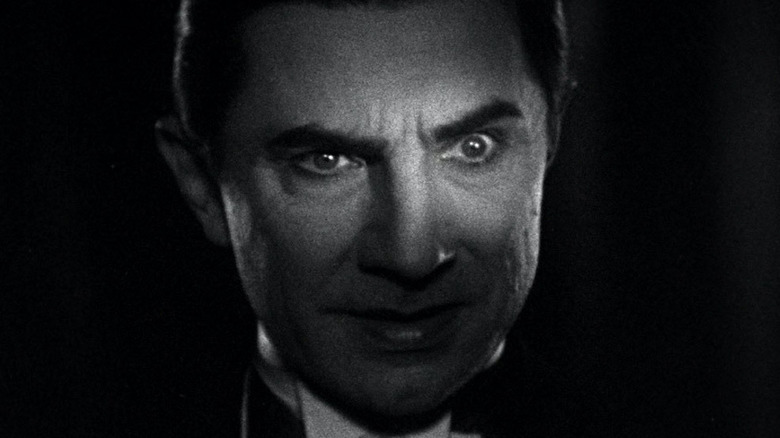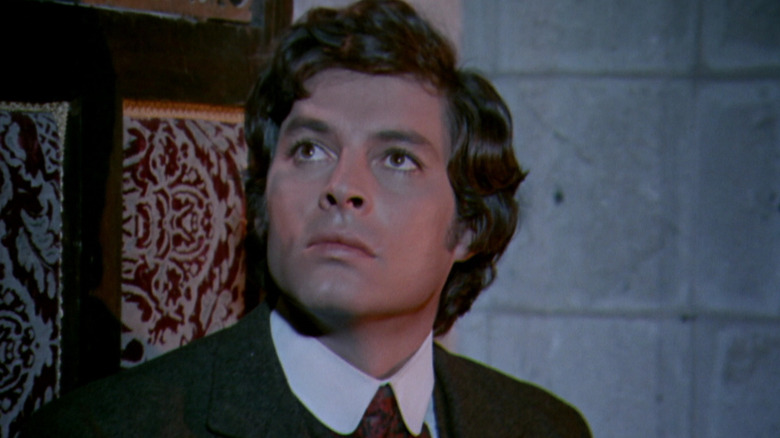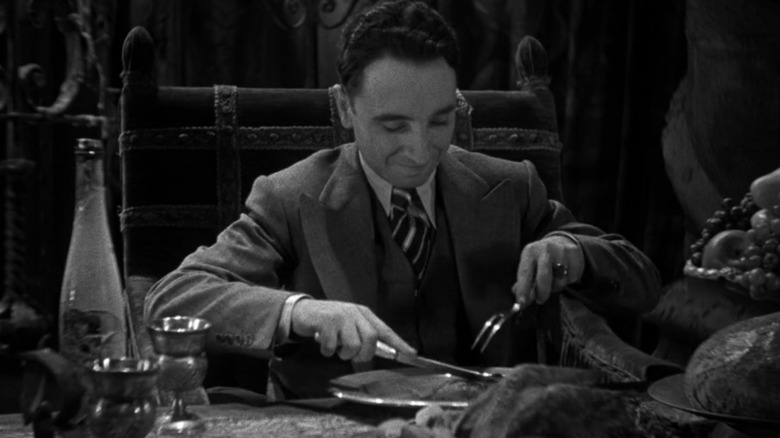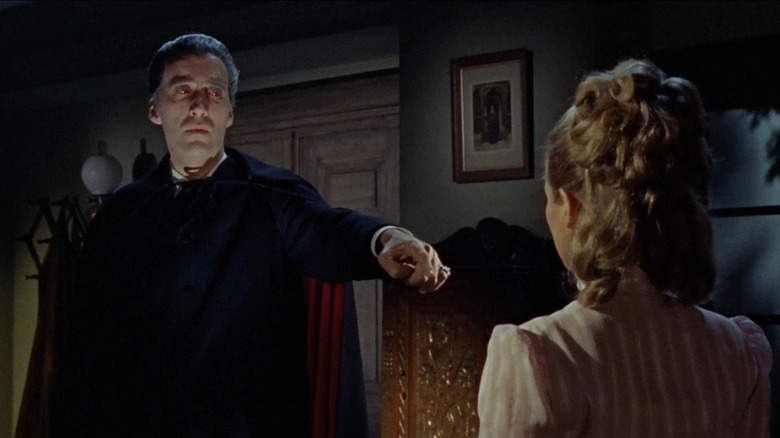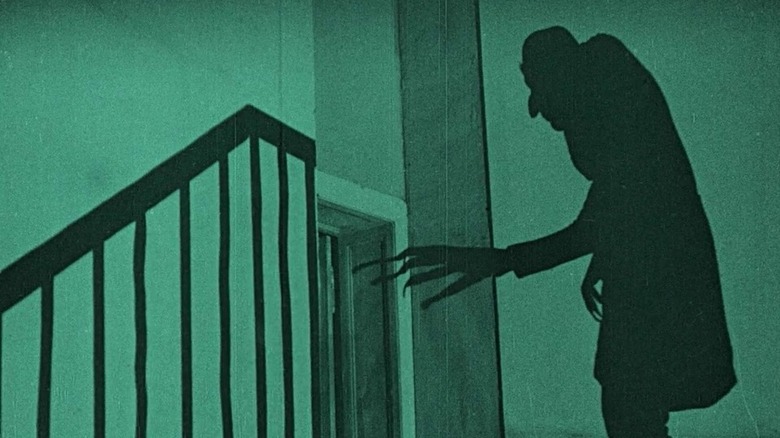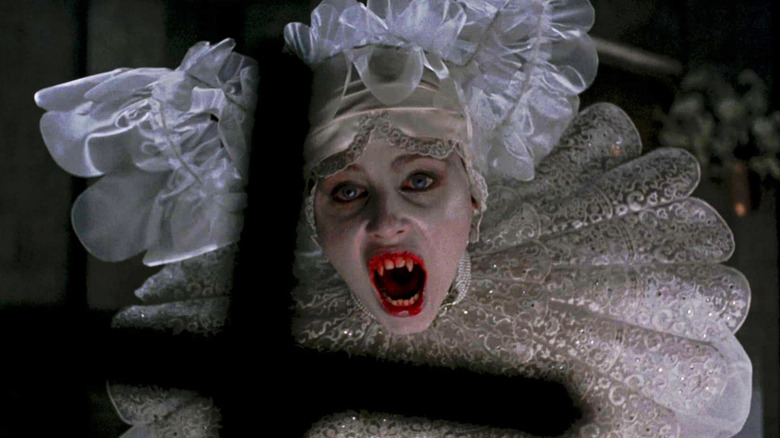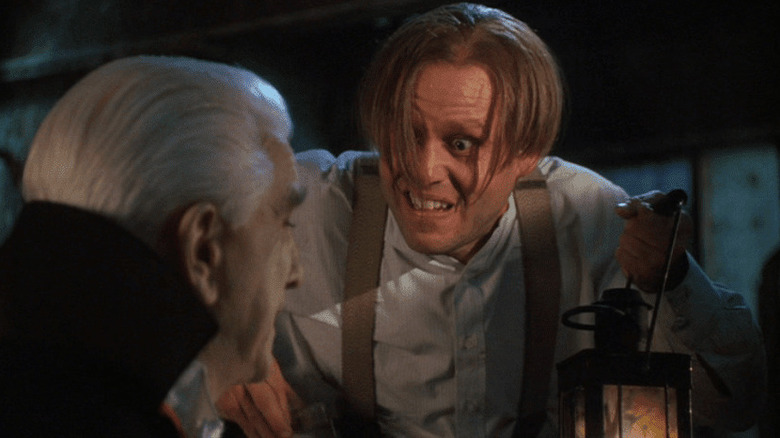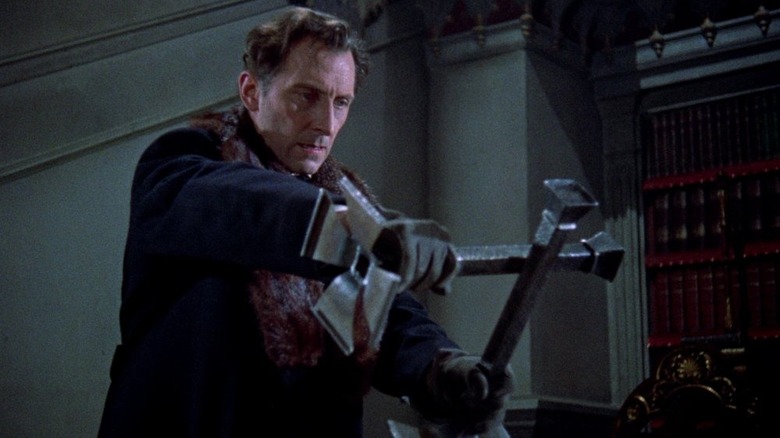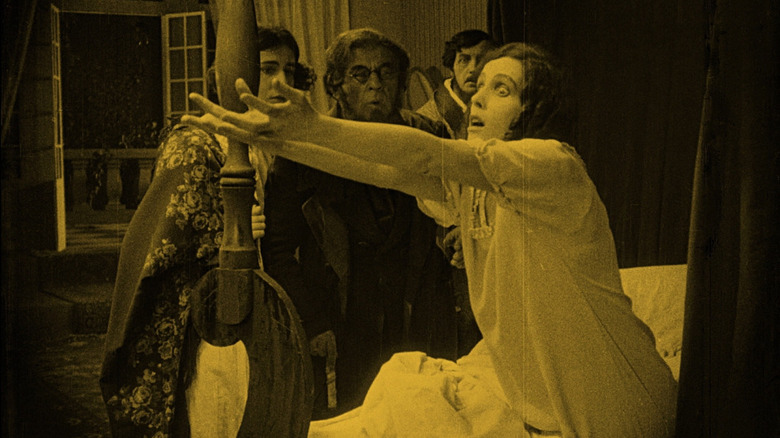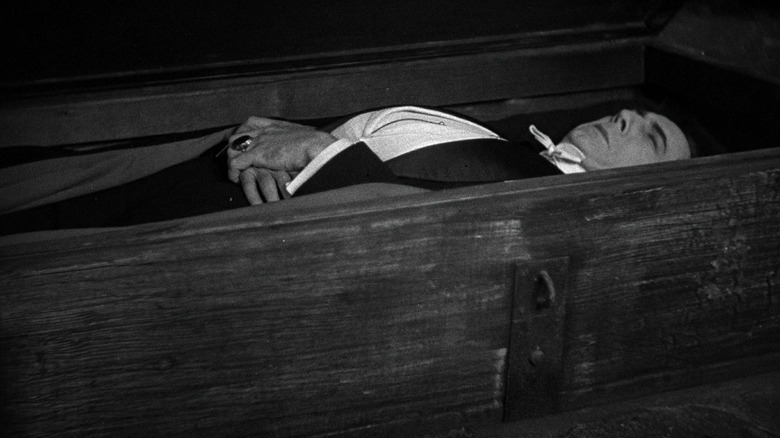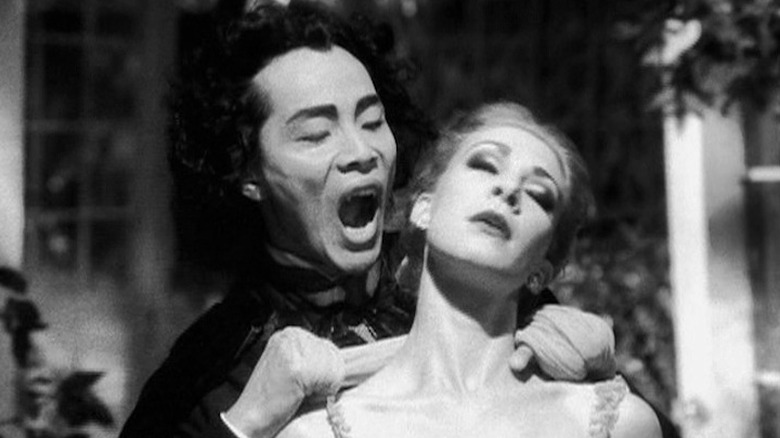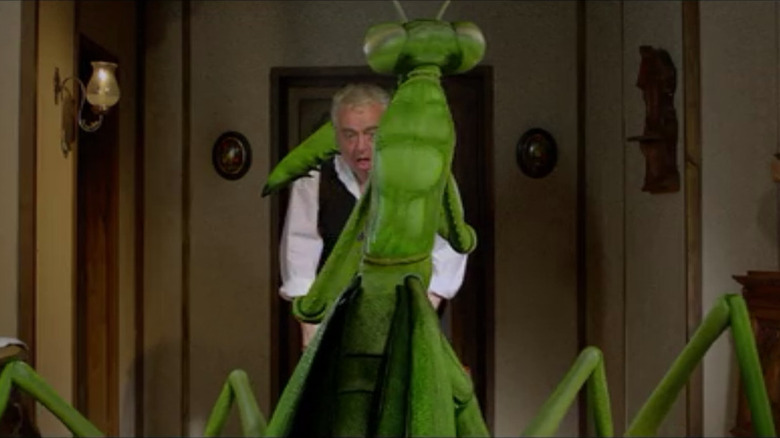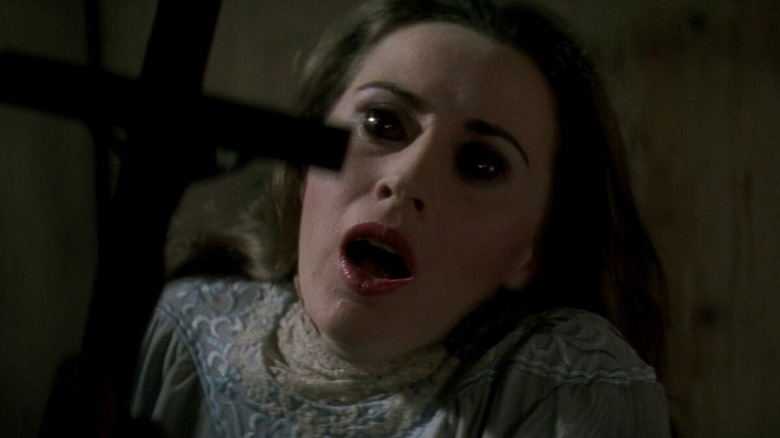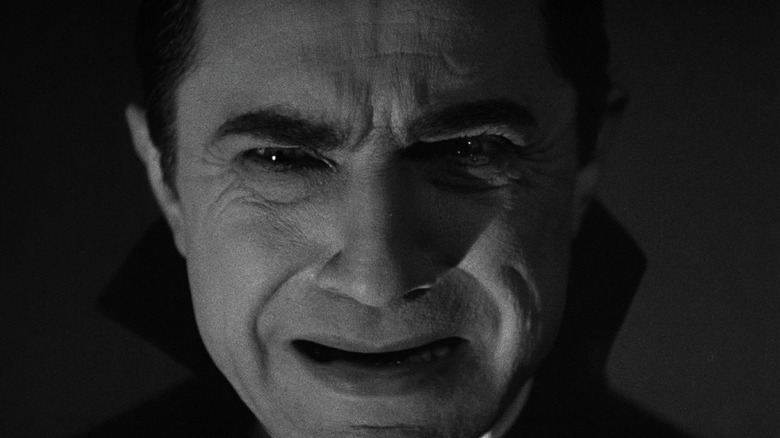Things That Happen In Every Dracula Movie
First published in 1897, Bram Stoker's "Dracula" rung in the new century with its intelligent, gruesome, and sensual reimagining of the vampire mythos. Poetically, Stoker's text and the advent of cinema took place within years of each other, with the Lumière brothers' displaying the Cinématographe a mere two years before "Dracula" hit shelves. Plenty of gothic creations shuffled and slinked across the big screen before the Count's frightful cinematic reign began. But, if you count F. W. Murnau's 1922 silent film "Nosferatu" (and we do), then Dracula is easily one of horror's longest-serving subjects.
While plenty of films tweak, cut, and twist Stoker's text, most movies follow the source material more or less faithfully. "Dracula" tells the timeless tale of an undead, bloodsucking Eastern European aristocrat who travels to England to prey on young women. Luckily a gaggle of heroic lads, led by the infamous Dr. Van Helsing, are on the case and keen to dispatch of the suave leech before he can bleed London dry. While each cinematic interpretation of Stoker's text seeks to bring something new to the table, there are some elements you can always count on that make "Dracula" feel like "Dracula." Read on for our look at the themes, images, plot beats, and characters who always make an appearance in any respectable "Dracula" movie.
1. A romantic estate clerk is summoned to Eastern Europe
If you're watching a "Dracula" movie, odds are it's going to kick off with a business trip. Before Count Dracula can make his way to London, he must follow the correct legal procedures to ensure that his move arouses the least amount of suspicion possible. And so, a young, wide-eyed real estate clerk (usually, but not always named Jonathan Harker) is summoned to Transylvania on behalf of his firm to seal the deal. Harker is our wide-eyed English everyman, unfamiliar with the country and its customs; a babe in the woods, who also just so happens to have a briefcase. Compounding the stakes (pun intended) of Harker's visit, the character tends to be a romantic, with a lovely fiancée at home eagerly awaiting his safe return.
The character appears as Thomas Hutter in 1922's "Nosferatu" and as an American realtor/lawyer in "Dracula Reborn" (2012) and "Dracula" (2002). There are plenty of films that faithfully portray the lovelorn solicitor (1977's "Count Dracula," 1970's "Count Dracula," and 1992's "Bram Stoker's Dracula"). And even when Harker's character is shifted, a replacement estate lawyer always takes his place. For example, both English and Spanish 1931 versions of "Dracula" and 1995's "Dracula: Dead and Loving It" recast Renfield in this role. Indeed, the only "Dracula" movies that seem to do away with the doomed real estate agent are the ones that start mid-way through Bram Stoker's text, when Dracula arrives in London (see: 1979's "Dracula" and 2002's "Dracula: Pages from a Virgin's Diary").
2. The journey to Dracula's estate is full of red flags
Jonathan Harker isn't the brightest bulb in the chandelier; that's part of the character's charm. One of the best indicators of the glossy-eyed solicitor's innocence is his very specific visual impairment: Harker is apparently unable to see red flags. Indeed, Harker is presented with a boatload of bad omens as he journeys to Count Dracula's castle. And because his head is full of cotton balls and love letters to his young bride-to-be, Harker takes note of the ominous portents of his doom and presses forward like a good, dutiful businessman.
In 1922's "Nosferatu," the young solicitor dismisses local warnings that a monster prowls the grounds of Dracula's estate. Similar hand waving takes place in Werner Herzog's 1979 remake (people disappear without a trace you say? No coach will travel to that part of the country? Must be a silly local superstition!). In Tod Browning's 1931 version of the tale, the young solicitor doesn't think twice when the frantic locals place a crucifix around his neck "for protection." And in Francis Ford Coppola's 1992 film, Keanu Reeves' Harker deserves extra "head empty" credit for seeing that his carriage pick-up spot was marked by a crucified wolf and all but shrugging.
3. Dracula's actually a pretty good host ... at first
Okay, sure, he's "a monster" and he "literally drinks blood," but to give credit where credit is due, Count Dracula is a pretty good host. Whenever some unsuspecting real estate agent comes calling, he always makes an effort to make them feel as comfortable as possible given the circumstances. In Tod Browning's 1931 film, the Count bids his flabbergasted guest welcome and escorts him to the part of the castle least coated in cobwebs (what a gentleman). And what's this? Is Dracula pouring his guest a glass of his finest wine? That feels unnecessary given the torment you're about to visit on this poor man.
Meanwhile, George Melford's 1931 take on Bram Stoker's text goes above and beyond, with Dracula treating his guest to a full-on feast of roast pheasant. Tellingly, in this version, Dracula's guest doesn't cut his finger with a letter opener, but with a bread knife. Bruno Ganz's real estate agent is treated to similar culinary delights in "Nosferatu the Vampyre," with the titular Count going so far as to wait upon his guest himself, as "servants are not at our disposal." Jonathan Harker is presented with yet another full roast fowl in 1992's "Bram Stoker's Dracula," which he happily digs into while the Count regales him with his family history. Sure, he waves a sword in Harker's face when the solicitor politely laughs, but hey, that's free dinner theater, baby.
4. Dracula is always a rich aristocrat
Horror, arguably more than any other film genre, is especially amenable to metaphor. It is a corner of film keenly interested in symbols, allusions, dream logic, and psychoanalytic interpretations. When you're wheeling and dealing in the realm of magic and monsters, the restrictive confines of reality become a lot easier to play around with. Dracula may be a supernatural creature. But his fangs aren't the only thing that makes him a formidable foe. Indeed, Dracula's wealth is a key part of what makes him so dangerous. He buys an estate in London through totally legal means. He bears all the outward signs of old high society and his "moneyed elite eccentricities" make him that much easier to dismiss.
Whereas the aristocracy bleeds the lower classes dry metaphorically, Dracula literally sucks the lifeblood out of mere mortals. Any self-respecting "Dracula" film understands that its titular villain's elevated status is a key part of what makes the character work. He is literally a Count, after all. Can you think of the last time you saw a working-class Count Dracula? Of course, you can't. From the marble-filled castle estate in "Dracula" (1958) to the Count's four meters wide (at least!) fireplace in 1970's "Count Dracula," one thing you can count on is the Count being high status and positively loaded.
5. The shadows have a mind of their own
Given that Count Dracula is an immortal bloodsucker with all manner of supernatural talents, it should come as no surprise that his shadow is similarly strange. Bram Stoker's text makes no overt mention of Dracula's shadow acting independently of its source, betraying the Count's predatory nature. But the image crops up repeatedly in the Count's cinematic outings, a monstrous shadow with grasping claws stretching across bare walls. Unlike most of the other items on this list, Dracula's seemingly independent shadow doesn't originate in Stoker's text, but from the cinematic tradition in which Dracula films were first birthed: German Expressionism. Predicated on giving emotional states of mind a physical presence, German Expressionism uses set design, cinematography, and costumes to portray a subjective, emotional world. For instance: conveying the far-reaching influence of the personification of evil via an exaggerated shadow.
One of the most memorable instances of German Expressionism takes place in 1922's "Nosferatu," when the ghastly shadow of Count Orlok (the film's stand-in for Count Dracula) ascends Ellen Hutter's staircase, his claw-like hand extending horribly towards the door. 70 years later, in Francis Ford Coppola's "Bram Stoker's Dracula," the nefarious Count's shadow would leer eagerly and hungrily while Dracula's physical form remained cordial.
6. Lucy contracts the vampire's curse
In the world of Bram Stoker's "Dracula," if you're not a virginal bride-to-be or a dutiful wife/mother, then you're a corrupted, fallen woman. At the beginning of the tale, both Mina and her best pal Lucy fall firmly into the latter category. They are committed to the men in their lives and are, for all intents and purposes, totally upstanding Victorian ladies. Until Dracula enters the picture, that is. After the blood-hungry Count seduces poor Lucy, the young Miss Westenra falls critically ill, ultimately succumbing to her tragic condition of "not having any blood left in her." In Stoker's text, Lucy's illness brings a gaggle of important characters together (including one Dr. Van Helsing), who steadily grow wise to the reality of the supernatural threat after the previously joyful young woman returns from the dead as a vampiric vixen.
Lucy being "turned" is an all-important piece of both the narrative and thematic puzzles of "Dracula." The tragic "fallen woman" can be spied (under a different name) in 1922's "Nosferatu," where she is reimagined as the sister of a British shipbuilder. Interestingly, a couple of "Dracula" films choose to swap Lucy and Mina's names around (1979's "Nosferatu" and "Dracula"), though the core of the characters remains the same. More traditional interpretations of the character's vampiric fate can be found in 1958's "Dracula," 2002's "Dracula: Pages from a Virgin's Diary," and 1970's "Count Dracula."
7. R. M. Renfield is an absolute lunatic
A number of characters are mainstays in any self-respecting "Dracula" film. While heroic figures like Van Helsing and Lucy's suitors are memorable, to be sure, none can hold a candle to R.M. Renfield. Renfield is, for lack of a more delicate term, an absolute lunatic. Part bonafide familiar and full parts wild-eyed super fan, Renfield is Dracula's man on the ground. You'd think the Count could find someone a little more, uh, sane. But blood-loving beggars can't be choosers. The deal is simple: Renfield helps Dracula, and Dracula dangles the promise of eternal life in front of Renfield's nose.
While some films play things more or less by the book (1979's "Love at First Bite," 2002's "Dracula," or 1977's "Count Dracula"), other films take creative liberties with Renfield's character to establish more of a concrete relationship between the madman and the Count. Both 1922's "Nosferatu" and Werner Herzog's 1979 remake combine Renfield and Mr. Hawkins, Jonathan Harker's boss at the real estate firm, a tradition Francis Ford Coppola's 1992 film keeps up by implying that Renfield was Harker's predecessor. The most famous alteration of the character occurs in both of the 1931 "Dracula" films, which swap Harker out for Renfield as the real estate agent who travels to Dracula's estate, where he falls under the vampire's spell.
8. Doctor Van Helsing to the rescue!
Whether he's a steely-nerved Brit or closer to the eccentric Dutchman of Bram Stoker's text, one thing you can always count on in any self-respecting "Dracula" film is the presence of Professor Abraham Van Helsing. An open-minded polymath and the only character in Stoker's text with prior knowledge of the existence of vampirism, Dr. Van Helsing is initially summoned through his connection to John Seward, his former student, who is attending to the soon-to-be-vampiric Lucy Westenra. Without the presence of Dr. Van Helsing, most "Dracula" movies would be about 30 minutes long, ending abruptly with Dracula laying waste to the whole of England, undisturbed. Thankfully, Van Helsing is wise to the Count's nefarious condition and is able to martial the available allies to perform the appropriate acts to cut the Count's influence off at the root.
Van Helsing first appeared in 1922's "Nosferatu," where he is renamed Professor Bulwer. Van Helsing appears in both of Universal's 1931 editions of "Dracula," as well as both 1979 "Dracula" films. You can spot Van Helsing in the Royal Winnipeg ballet's adaptation of Stoker's text, and you can even find him in the 1995 spoof "Dracula: Dead and Loving It," where he is portrayed by the film's director, Mel Brooks. Arguably, just as you can't have a Dracula movie without a Count, you can't have one without a Van Helsing. They were made for each other.
9. Dracula tends to have the power to invade dreams
One of Dracula's most unnerving powers is the ability to invade the minds of others. He is able to manipulate the terminally mentally unwell Renfield, and, unfortunately for poor young Lucy Westenra, the Count appears to be equally influential over sleepwalkers. In Todd Browning's 1931 film, Ellen Hutter assumes the role of the somnambulist, lured to the balcony railings where she has a vision of the nefarious count preying upon her husband. In the 1977 BBC adaptation of Stoker's text, Lucy sleepwalks through town, up a cliff, through a graveyard, and straight into Dracula's open arms.
In the 1992 film, Francis Ford Coppola emphasizes Dracula's power over Lucy's subconscious slumber — with the poor victim compelled, night after night, to act like the Count's own personal blood bag. In the 1968 TV movie, Dracula repeatedly feeds on Lucy while she writhes in the throes of a bad dream. There's even a moment where he compels Lucy, as she sleeps, to dislodge her protective rosary so that he can feed, uninterrupted.
If you or someone you know needs help with mental health, please contact the Crisis Text Line by texting HOME to 741741, call the National Alliance on Mental Illness helpline at 1-800-950-NAMI (6264), or visit the National Institute of Mental Health website.
10. Vampires like to snooze in coffins
There are a number of reasons why you would assume that sleeping in a coffin might be less than ideal. Even if you can get over the claustrophobia, such a stiff and confined space might lead to some serious aches and pains in the morning. But hey, if your goal is to be shielded from all the surrounding sunlight (and to discourage curious folks from exposing you to stray sunbeams), a coffin is definitely the way to go. Is a "Dracula" movie really a "Dracula" movie if the Count doesn't sleep in a coffin?
Our wide-eyed protagonist stumbles across Count Orlok snoring away in a coffin in 1922's "Nosferatu," and both 1931 Universal Pictures films conclude with our heroes staking Dracula through the heart while he dozes the doze of the dead in the catacombs. In 1958's "The Return of Dracula," the Count ups the ante by sleeping in a coffin in an abandoned mine (no sunlight there!), and we see the vampiric brides also resting in coffins in 1970's "Count Dracula" and the 1971 Czech TV movie "Hrabě Drakula." So scoff all you want, soft-mattress lovers, but clearly, it's not the hardware that's the problem. These vampires are sleeping the sleep of the dead. (Until some heroic ding dong with a steak comes calling, that is.)
11. The vampire's kiss is always super eroticized
Is there a way to suck the blood out of someone's neck without making it an erotic thing? Absolutely, but don't tell that to Count Dracula. Sexual undertones pervade Bram Stoker's original text, which was, among other things, keenly interested in divining horror out of repressed Victorian morales, particularly as they related to "good" and "bad" expressions of female pleasure. Dracula is a seducer, luring his young, female victims through hypnotic suggestion, preying, quite literally, on chaste women he hopes to defile through his "bite." You get our drift.
The visual double entendre of "Dracula's kiss" is something most films are keen to lean into. Both of the pre-code Universal Pictures "Dracula" films feature imagery of the Count leering over the necks of sleeping women and enveloping innocent victims within his cavernous cape. But it's Guy Maddin's silent era pastiche, "Dracula: Pages from a Virgin's Diary" that presents us with some of the most sensual bloodsucking in the Count's cinematic cannon, with Lucy's pained, muted sighs being equally interpretable as rapturous.
12. The count usually has the ability to turn into some kind of animal
Dracula has always had a strong connection with other creatures of the night. In Bram Stoker's original text, vampire expert Van Helsing specifies that the Count can command and transform into "all the meaner things, the rat, and the owl, and the bat, the moth, and the fox, and the wolf." The infamous vampire's talent for changing into fearsome creatures is a mainstay in his cinematic tenure. The Count tends to transform into the same kinds of animals, the most popular being a wolf (1974's "Bram Stoker's Dracula," 1977's "Count Dracula") and a bat (1977's "Dracula's Dog," 2014's "Dracula Untold," and 1931's English-language "Dracula").
The predator motif — and Dracula's mastery over some of nature's most infamous predators — emphasizes the Count's ravenous power. However, not all of the Count's animalistic forms are created equal. Francis Ford Coppola's "Bram Stoker's Dracula" features an especially memorable menagerie, including a hairy, snub-nosed man-beast and a big twisting pile of rats in the shape of a person. But as far as the "out there" Dracula transformations go, no film can hold a candle to Dario Argento's "Dracula 3D," which features a scene in which the Count transforms into an enormous praying mantis.
13. Vampires have specific weaknesses
While vampires are an intimidating threat, they do have a pretty reliable Rolodex of weaknesses. As evidenced in the 1931 Universal Pictures adaptation, Dracula is not a huge fan of crucifixes. And in 1958's Hammer Horror film, when a well-meaning helping hand tries to give the infected Mina a cross, the religious symbol burns her skin, leaving a scar in its place. Later in the film, Van Helsing even manages to ward off Dracula with an improvised cross made out of candlesticks.
As per Bram Stoker's text, garlic is another one of the ways to ward off Dracula, whose supernatural sensitivities clearly can't deal with the vegetable's high sulfur content. Van Helsing fills the ailing Lucy's bedroom with garlic in a number of films, including 1977's "Count Dracula," in which he later fills the undead Lucy's mouth with garlic before slicing her head off. A stake through the heart is a perfectly acceptable and sure-fire way to do away with old Drac (as seen in both 1931 "Dracula" films and "Dracula: Pages from a Virgin's Diary"). But never underestimate the power of a well-timed beam of sunshine (1922's "Nosferatu," 1970's "Count Dracula," and 1958's "Horror of Dracula").
14. The Count is always pitiful, to a degree
While Bram Stoker's text is more or less opposed to humanizing "Dracula," filmmakers have been hard at work giving the Count a more empathetic reading. A good deal of films — including 1979's "Love At First Bite" and 1992's "Bram Stoker's Dracula" — turn Dracula into a hopeless romantic who sees in Mina Harker a reincarnation of his long-lost love. By casting Chinese-Canadian Zhang Wei-Qiang as the titular Count, Guy Maddin's "Dracula: Pages From a Virgin's Diary" emphasizes the orientalism and xenophobic anxieties of Stoker's text.
Notably, Christopher Lee made a distinct effort to infuse pathos into his portrayal(s) of the notorious Count. As Lee recalled in a 1990 NPR interview, the actor saw "something in the character which other people hadn't ... that the character is heroic, erotic, and romantic." In an interview reprinted in John L. Flynn's "Cinematic vampires: the living dead on film and television" Lee specified that he "always tried to put an element of sadness, which I've termed the loneliness of evil, into his character. Dracula doesn't want to live, but he's got to! He doesn't want to go on existing as the undead, but he has no choice."
